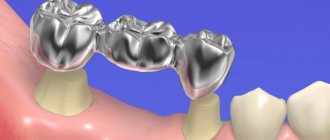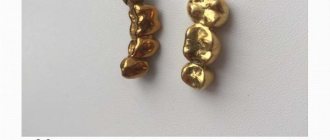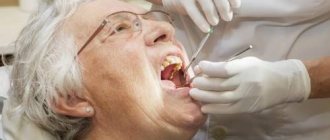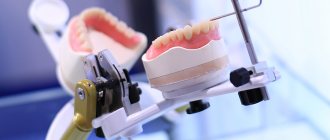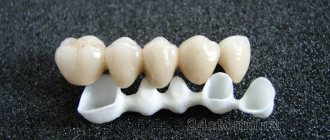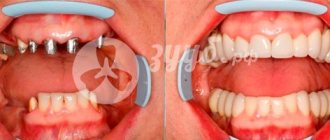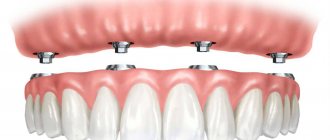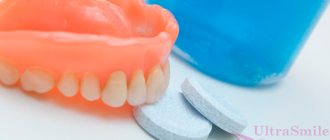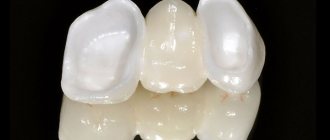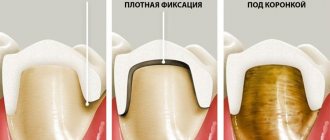This article is about fitting a removable denture. Identifying errors and correcting them. And also about the rules for using complete removable dentures.
Article outline:
— Stages of fitting and applying the prosthesis
— Correction of errors that were undetected before
— Recommendations for the patient
— Correction of the prosthesis.
The appointed patient came to the doctor. Finally the work is finished and today he will start wearing his long-awaited prosthesis. But the doctor knows that there is still a lot of work ahead.
After greeting, he seats the patient in a chair. Wears gloves and a mask. The technician handed over the finished work yesterday. Now the doctor needs to check everything again.
Removable denture technology
When a person does not have a single tooth left in one or both jaws, the orthopedic dentist has only two options: to perform expensive partial dental implantation, and then create a permanent structure on the installed implants, or to restore the dentition using completely removable structures, which are created from individual impressions for both the lower and upper jaws.
When used correctly and carefully, removable dentures made from modern materials will serve for a long time as a safe and effective replacement for natural teeth. The advantages of completely removable prosthetics are as follows:
- individual choice of teeth according to shape, size and color;
- excellent aesthetic properties of the prosthetic structure, achieved through the use of modern orthodontics and the latest technologies;
- ease of care for artificial teeth;
- long service life of removable dentures when used carefully, which is achieved through the use of modern wear-resistant materials;
- convenience for effectively maintaining the health of the oral cavity and gums;
- no need to constantly remove dentures while sleeping;
- affordable price.
As for the disadvantages of a completely removable orthopedic design, the following are worth mentioning:
- a fairly long period of adaptation, during which a person long feels the unfamiliarity and foreignness of the prosthetic structure;
- there is a risk of finding yourself in an awkward situation when a removable prosthetic structure accidentally falls out of your mouth at the most inopportune moment;
- constant difficulty chewing solid food;
- the need to use gels to provide a suction effect when finding a prosthetic structure;
- changes in the load on the gums, which can lead to problems in the oral cavity;
- the need to constantly remove the orthopedic structure, clean and treat it with special means.
Not only orthopedic dentists, but also dental technicians are involved in the manufacture of removable dentures. The first ones prepare for the creation of a dental structure and install it on the patient. And the latter make removable dentures in special laboratories. This process requires high qualifications and experience. Dental technicians select materials, create the required relief that matches the relief of the patient’s natural teeth, and give artificial teeth the necessary shape and color so that they do not differ in appearance from natural teeth. The production of prosthetic structures by a dental technician is partly akin to science, partly to art. And the profession of a dental technician has a certain similarity with the profession of a sculptor or artist.
Differences between fixation on the upper and lower jaw
Partial dentures are fixed to the gums using a base, as well as to supporting teeth using hooks. The device looks like a plastic arch with artificial crowns. The main difference is in the design of the palatal bridge.
The dentures for the top row are equipped with an artificial plastic palate (solid plate). The element increases the area of contact surfaces, thereby improving fixation. The devices are bulky, making it more difficult for patients to get used to them. But in the new generation of prostheses, this element is made in the form of a ring or arc, which makes the design easier.
On the lower jaw the bridge is narrow due to the frenulum of the tongue. The contact area is small, but this reduces the quality of fixation.
Stages of making dentures
As noted above, before the manufacture of removable prosthetic structures in a special laboratory, clinical preparation for this work is carried out. Within its framework, the physiological characteristics of the patient for whom the denture is made are assessed, and aesthetic nuances are also taken into account - the appearance and facial characteristics of the patient. The entire procedure for manufacturing a prosthetic structure consists of the following steps:
- Preparation for prosthetics.
At this stage, the patient is examined, the condition of the dental system is diagnosed, and a suitable prosthetic structure is selected. An orthopedic dentist cleans teeth and gums from deposits and defects, removes tartar, treats caries and, if necessary, installs fillings.
- Taking impressions. At this stage, the prosthodontist takes impressions of the patient's teeth using a standard impression tray. Depending on the selection of the design, the impression mass is selected.
- Making a model of the jaw. At this stage, the dentist transfers the impression to a specialized laboratory. The dental technician fills it with plaster, and after hardening it takes on the desired shape of the teeth and jaw. The dental technician then makes custom impression trays using plaster models of the jaws.
- Imprints of the patient's teeth are taken using individual impression trays.
- On working models, a wax base is made with occlusal ridges, which are subsequently used to determine the relative position of the jaws.
- The occlusal ridges and working models are secured in the articulator.
- The future prosthetic structure is made from wax with teeth from the selected material (for example, acrylic).
- The prosthetic structure is checked in the patient’s oral cavity, occlusion, fit, and aesthetic qualities of the product are assessed.
- The final wax modeling of the dental structure is performed.
- The wax composition is cast into a ditch and the wax is replaced with the selected material (for example, acrylic).
- The prosthetic structure is removed from the cuvette, ground and polished.
- After checking the prosthetic structure, if necessary, it is returned to a special laboratory for modification.
- The finished prosthetic structure is handed over to the patient.
The most frequently asked questions about partial dentures
Is an allergy possible? How long does it take to get used to? Do you need fixing gels when wearing? You can find out the answers to these and other most popular questions in this section of the article.
— Is it possible to have an allergic reaction?
Is it possible. As a rule, an allergy can occur to acrylic when wearing plate dentures. Or on metal if wearing a clasp design. Before installing a prosthesis, a doctor may recommend that particularly sensitive people undergo a special test for sensitivity to materials.
— How long does it take to get used to it?
Sometimes it can take up to 3-4 weeks to get used to it. This usually applies to plate dentures, since they are more noticeable in the oral cavity. Clasp designs do not require so much time.
— Do I need to use fixing gels when wearing partial structures?
Partial structures do not require additional fixation, since they already have fastenings (hooks or clasps).
— Do I need to take off my dentures at night?
It is not at all necessary to remove the structure at night. It is not even recommended to remove the prosthesis for the first 3-4 weeks after installation, since there is an adaptation period. Further, at the discretion of the patient.
— Are there any restrictions when wearing?
Avoid eating excessively hard foods such as nuts or ice. It is also not recommended to eat foods that are too viscous and stick to artificial teeth.
Technique for making removable dentures
Poor chewing of food due to missing teeth can impair the functioning of the gastrointestinal tract. In some cases, the only way to restore chewing function, which is extremely important for maintaining health, and to regain a beautiful smile, is to make removable dentures. technology protects the jaws from further destruction. The manufacture of removable dentures is carried out in cases where natural teeth for some reason could not be preserved. Removable prosthetic structures are attached to the jaw due to the ability to stick to it. They have the shape of curved plates on which artificial teeth are installed. The shape and color of the teeth are selected according to the individual needs and wishes of the patient. The color of a removable denture is as close to natural as possible. How are removable dentures made today? The technology of making dentures has now reached a level that far exceeds that of the recent past. Modern production of dentures is based on the use of new technologies and materials. Thanks to the successes that dentistry has achieved to date , removable dentures have high strength characteristics, aesthetic properties and hygienic qualities. Removable prosthetic structures have no age restrictions, and their manufacture takes into account the individual characteristics of the patient’s jaws, thereby minimizing discomfort when using them. Of course, dentures should not cause discomfort in the mouth. For this reason, dentists advise not to remove them for the first time after installation, so you can monitor the human body’s reaction to them and make adjustments if necessary.
List of contraindications
Restrictions on the installation of removable laminar dentures are divided into absolute and relative. In the first case, the product cannot be used due to the impossibility of changing the general somatic condition of the patient. This is observed when:
- schizophrenia;
- epilepsy;
- dental pathologies that cannot be treated;
- individual intolerance to the prosthetic material.
In the group of relative contraindications to wearing a removable structure:
- bite pathologies;
- tuberculosis;
- actinomycosis;
- periodontal diseases;
- infections, acute inflammatory processes;
- rehabilitation after stroke/heart attack;
- exacerbation of a chronic disease.
In the latter cases, the design can be worn only after recovery or the disease has entered the remission stage.
Cost of a complete removable denture
The price of a prosthetic structure depends on several factors. One of them is the cost of the materials used. For example, a removable denture made of plastic costs much less than one made of nylon. Another important component of the cost of full dentures is the labor costs of the technicians. In addition, the price of a dental structure includes the cost of using the equipment with which it was made. In addition, the technology used plays a role. Therefore, even two prosthetic structures made from the same material may have different costs. This is due to the difference between types of fastenings, sets of teeth, etc. The final price is determined after consultation with a dentist and discussion of various prosthetic options. In this case, the condition of the patient’s jaws, wishes and financial capabilities of the patient are taken into account. In general, the cost of a complete removable denture is much less than the cost of implants, so anyone with a small income can solve this problem.
Manufacturing time for removable dentures
The speed of manufacturing dentures depends on several factors, the main ones being the materials and technologies used. If you answer approximately the question of how long it takes to make a removable denture , then you can focus on the following time frames.
- Clasp dentures on telescopic crowns are made in approximately three to four weeks;
- Clasp dentures with attachments are manufactured in approximately twenty days;
- Clasp dentures with hooks are made in about ten to twelve days;
- Plate dentures are made in approximately thirteen to sixteen days;
- Soft plastic dentures are made in about five to ten days;
- Nylon dentures take approximately seven to ten days to complete.
How to choose the best option
| Properties | Acrylic | Nylon | Akri-Free | Byugelny | Quadrotti | Sandwich | Butterfly |
| Aesthetics | average | high | high | relative | high | high | average |
| Strength | low | low | high | high | high | high | low |
| Allergy risk | There is | No | No | There is | No | There is | There is |
| Fixation | bad | bad | average | very good | good | good | bad |
| Comfort | short | short | high | average | high | average | average |
| Repair | available | not possible | available | available | available | available | available |
| Turning supports | not always | need not | need not | not always | need not | need not | need not |
| Service life (years) | 3-4 | 1,5-3 | 7-10 | 5-7 | 5-7 | 5-7 | 1-18 months |
| Price | low | low | average | high | high | high | low |
Materials for the manufacture of removable dentures
The main requirements for the materials from which removable dentures are made are non-toxicity and the ability to look natural. A number of materials are used for these purposes, including:
- acrylic;
- plastic;
- zirconium;
- nylon;
- pressed ceramics;
- silicone;
- polyurethane;
- metal ceramics;
- clasp.
Based on what kind of material is used to create removable dentures, they receive certain properties. For example, the advantages of products made from metal ceramics and acrylic are strength and attractive appearance, while the advantage of products made from polyurethane and nylon is their flexibility. As for the shape and color of removable dentures, in all cases they are determined individually. Modern technologies provide the opportunity to create products with high aesthetic properties. Each of the listed materials has its own advantages and disadvantages. Therefore, when choosing, it is necessary to take into account the characteristics of each material and its suitability to your own needs. In solving this problem, recommendations from dentists can be of significant help.
Category Dentures Posted by admin
What do patients say?
Patient reviews of partially removable laminar dentures are ambiguous. Some patients report severe discomfort when wearing products (gums hurt, impaired diction appears) at the stage of getting used to the design. Most patients manage to get used to the dentures after 2 months of wearing them regularly.
Patients who chose nylon products praise their appearance and note the plasticity and softness of the material. Cases of complications have not been described by patients.
Considering the characteristics of plate products, dentists advise using them as temporary structures until it becomes possible to install fixed dentures.
